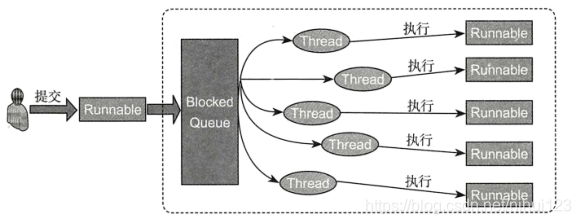之前博客的所有内容是对单个线程的操作,例如有Thread和Runnable的使用以及ThreadGroup等的使用,但是对于在有些场景下我们需要管理很多的线程,而对于这些线程的管理有一个统一的管理工具叫做线程池,线程池就是管理很多的线程的一个集合。这篇分享中提出的一个就是关于线程池的概念。
线程池原理
从JDK1.5开始,utils包提供了一个类ExecutorService,这个类是对线程池的实现,关于线程Thread来说,它的整个生命周期中都是需要很好的管理,但是我们频繁的创建或者是销毁线程极大的浪费了系统的资源,那么就需要将线程进行重复的利用。基于这个需求设计出了线程池。
所谓的线程池,从字面上理解就是存放线程的一个容器。当某个任务需要执行的时候,在线程池里的线程就会主动调用这个任务。但是还需要知道这个线程池的资源也是有限的,什么时候对于线程池的资源进行回收,什么时候进行线程的补充,什么如果达到容量之后继续提交任务会是什么状态等等。
基于上面的描述可以知道一个线程池主要具备的要素有以下一些
- 任务队列,用来缓存提交的任务
- 线程池数量管理功能,在线程池执行的任务要在一个可以控制的范围内。例如在使用线程池的时候最为经典的三个参数,第一个参数就是初始化线程的数量,第二参数就是可以扩展的线程池的最大容量,第三个参数就是线程池所能执行的核心任务的数量。其中这个核心线程的数量表示当线程池闲置的时候也要维护的线程的数量。、
- 任务的执行策略,对于正在执行的线程如果达到了线程池的最大容量,之后需要对于后来的任务进行拒绝操作。或者是通知提交者没有资源可以执行了。
- 线程工厂。通过线程工厂可以定制对应的需要执行的是什么样的线程。
- 队列大小,也就是当线程池资源已经占满的时候,需要在队列里面继续缓存任务,但是这个任务并不是可以无限缓存的所以对对应的任务队列也要进行大小的限制。
- 保持存活的时间KeepLive,对于各个线程来说都要有自己所要维护的任务的时间间隔,如果在这个时间内没有获取到资源就会执行回收。

自定义线程池各功能策略实现
通过上面的分析,我们知道了线程的几个重要的因素。下面就来自己实现一个线程池。
1.创建线程池接口
public interface ThreadPool {
//提交执行任务到线程池中
void execute(Runnable runnable);
//关闭线程池
void shutdown();
//获取线程池初始化大小
int getInitSize();
//获取线程池最大链接数
int getMaxSize();
//获取线程池需要维护的核心线程数
int getCoreSize();
//获取线程池中用于缓存任务队列的大小
int getQueueSize();
//获取线程中活跃线程的大小
int getActiveCount();
//判断线程是否已经被shutdown
boolean isShutdown();
}
2.创建线程队列接口
public interface RunnableQueue {
//当有新任务的时候首先进入到offer中
void offer(Runnable runnable);
//通过take方法获取到任务
Runnable take();
//获取任务队列中任务的数量
int size();
}
3.实现一个线程工厂
定义了一个函数式接口
@FunctionalInterface
public interface ThreadFactory {
Thread createThread(Runnable runnable);
}
4.实现决绝策略
@FunctionalInterface
public interface DenyPolicy {
void reject(Runnable runnable,ThreadPool threadPool);
class DiscardDenyPolicy implements DenyPolicy{
@Override
public void reject(Runnable runnable, ThreadPool threadPool) {
//do nothing
}
}
class AbortDenyPolicy implements DenyPolicy{
@Override
public void reject(Runnable runnable, ThreadPool threadPool) {
throw new RunnableDenyException("The runnable "+runnable+" will be abort.");
}
}
class RunnerDenyPolicy implements DenyPolicy{
@Override
public void reject(Runnable runnable, ThreadPool threadPool) {
if (!threadPool.isShutdown()){
runnable.run();
}
}
}
}
public class RunnableDenyException extends RuntimeException{
public RunnableDenyException(String message) {
super(message);
}
}
5.实现线程池调用策略
public class InternalTask implements Runnable {
private final RunnableQueue runnableQueue;
private volatile boolean running = true;
public InternalTask(RunnableQueue runnableQueue) {
this.runnableQueue = runnableQueue;
}
@Override
public void run() {
//如果当前任务正在执行并且没有被中断,则需要不断的从Queue中获取任务到run方法中
while (running&& !Thread.currentThread().isInterrupted()) {
try{
Runnable task = runnableQueue.take();
task.run();
}catch (Exception e){
running = false;
break;
}
}
}
public void stop(){
this.running = false;
}
}
自定义线程池各功能详细实现
线程队列的设计
做完基本设计之后剩下的就是对于基本功能的实现,首先是对外部线程队列的实现,对这个线程队列来说,有几个需要注意点,第一个就是队列的大小,第二个就是队列的拒绝策略。也就是是说当队列达到上限之后应该怎么处理。
public class LinkedRunableQueue implements RunnableQueue {
//任务队列最大容量
private final int limit;
private final DenyPolicy denyPolicy;
private final LinkedList<Runnable> runnableList = new LinkedList<>();
private final ThreadPool threadPool;
public LinkedRunableQueue(int limit, DenyPolicy denyPolicy, ThreadPool threadPool) {
this.limit = limit;
this.denyPolicy = denyPolicy;
this.threadPool = threadPool;
}
@Override
public void offer(Runnable runnable) {
synchronized (runnableList){
if (runnableList.size() >= limit){
denyPolicy.reject(runnable,threadPool);
}else {
runnableList.addLast(runnable);
runnableList.notifyAll();
}
}
}
@Override
public Runnable take() {
synchronized (runnableList){
while (runnableList.isEmpty()){
try {
runnableList.wait();
} catch (InterruptedException e) {
e.printStackTrace();
}
}
return runnableList.removeFirst();
}
}
@Override
public int size() {
synchronized (runnableList){
return runnableList.size();
}
}
}
其中两个比较关键的方法一个是offer一个take,在offer方法中如果队列达到上限会执行拒绝策略,否则将继续往队列中放入执行的任务,同时唤醒take的任务线程。take会不断的从队列中获取任务,当队列为空的时候会进入阻塞状态,这个有可能在阻塞的过程中会被中断,所以处理异常的时候要对异常进行thow处理。也就是说对异常进行抛出而不是catch。
线程池的设计
根据前面的设计来开一个线程池有很多的控制属性、例如线程池大小、核心线程数、最大线程数、等等。
public class BasicThreadPool extends Thread implements ThreadPool {
private final int initSize;
private final int maxSize;
private final int coreSize;
private int activeCount;
private final ThreadFactory threadFactory;
private final RunnableQueue runnableQueue;
private volatile boolean isShutdown = false;
private final Queue<ThreadTask> threadQueue = new ArrayDeque<>();
private final static DenyPolicy DEFAULT_DENY_POLICY = new DenyPolicy.DiscardDenyPolicy();
private final static ThreadFactory DEFAULT_THREAD_FACTORY = new DefaultThreadFactory();
private final long keepAliveTime;
private final TimeUnit timeUnit;
public BasicThreadPool(int initSize,int maxSize,int coreSize,int queueSize){
this(initSize,maxSize,coreSize,DEFAULT_THREAD_FACTORY,queueSize,DEFAULT_DENY_POLICY,10,TimeUnit.SECONDS);
}
public BasicThreadPool(int initSize, int maxSize, int coreSize, ThreadFactory threadFactory,int queueSize, DenyPolicy denyPolicy,long keepAliveTime, TimeUnit timeUnit) {
this.initSize = initSize;
this.maxSize = maxSize;
this.coreSize = coreSize;
this.threadFactory = threadFactory;
this.runnableQueue = new LinkedRunableQueue(queueSize,denyPolicy,this);
this.keepAliveTime = keepAliveTime;
this.timeUnit = timeUnit;
this.init();
}
private void init(){
start();
for (int i = 0; i < initSize; i++) {
newThread();
}
}
private void newThread() {
InternalTask internalTask = new InternalTask(runnableQueue);
Thread thread = this.threadFactory.createThread(internalTask);
ThreadTask threadTask = new ThreadTask(thread,internalTask);
threadQueue.offer(threadTask);
this.activeCount++;
thread.start();
}
private void removeThread(){
ThreadTask threadTask = threadQueue.remove();
threadTask.internalTask.stop();
this.activeCount--;
}
@Override
public void run() {
while (isShutdown&& !isInterrupted()){
try {
timeUnit.sleep(keepAliveTime);
} catch (InterruptedException e) {
isShutdown = true;
break;
}
synchronized (this){
if (isShutdown){
break;
}
if (runnableQueue.size()>0&& activeCount<coreSize){
for (int i = initSize; i < coreSize ; i++) {
newThread();
}
continue;
}
if (runnableQueue.size()>0&& activeCount<maxSize){
for (int i = coreSize; i < maxSize ; i++) {
newThread();
}
}
if (runnableQueue.size()==0&& activeCount>coreSize){
for (int i = coreSize; i < activeCount ; i++) {
removeThread();
}
}
}
}
}
private static class ThreadTask{
Thread thread;
InternalTask internalTask;
public ThreadTask(Thread thread,InternalTask internalTask){
this.thread = thread;
this.internalTask = internalTask;
}
}
@Override
public void execute(Runnable runnable) {
if (this.isShutdown){
throw new IllegalStateException("The thread pool is destory");
}
this.runnableQueue.offer(runnable);
}
@Override
public void shutdown() {
synchronized (this){
if (isShutdown){
return;
}
isShutdown =true;
threadQueue.forEach(threadTask -> {
threadTask.internalTask.stop();
threadTask.thread.interrupt();
});
this.interrupt();
}
}
@Override
public int getInitSize() {
if (isShutdown){
throw new IllegalStateException("The thread pool is destory");
}
return this.initSize;
}
@Override
public int getMaxSize() {
if (isShutdown){
throw new IllegalStateException("The thread pool is destory");
}
return this.maxSize;
}
@Override
public int getCoreSize() {
if (isShutdown){
throw new IllegalStateException("The thread pool is destory");
}
return this.coreSize;
}
@Override
public int getQueueSize() {
if (isShutdown){
throw new IllegalStateException("The thread pool is destory");
}
return this.runnableQueue.size();
}
@Override
public int getActiveCount() {
synchronized (this){
return this.activeCount;
}
}
@Override
public boolean isShutdown() {
return this.isShutdown;
}
private static class DefaultThreadFactory implements ThreadFactory{
private static final AtomicInteger GROUP_COUNTER = new AtomicInteger(1);
private static final ThreadGroup group = new ThreadGroup("TestGroup-"+GROUP_COUNTER.getAndDecrement());
private static final AtomicInteger COUNTER = new AtomicInteger(0);
@Override
public Thread createThread(Runnable runnable) {
return new Thread(group,runnable,"thread-pool-"+COUNTER.getAndDecrement());
}
}
}
对于一个线程池来说,既要有对参数的控制,还要有对活动的控制,当线程执行的时候需要有一个执行线程的方法,将线程放入到线程队列中去执行。
在执行线程的过程中线程池还有自我维护的功能,也就是说,在执行操作的过程中的健壮性
- 当任务队列中出现任务积压的时候,并且当前活动的线程少于核心线程的时候,则需要重新建立核心线程和初始化的线程,并且要加入到线程活动队列中,防止马上进行最大线程的扩展,导致系统崩溃。
- 任务队列中出现任务积压,并且当前活动线程少于最大线程数的时候,则需要新建最大线程和核心线程并且将其加入到活动队列中。
- 当线程池不忙的时候,回收到核心线程数即可,也就是removeThread方法中需要考虑的问题。
线程池的销毁策略
线程池作为需要多个线程同时访问的对象,难免会出现线程安全问题,使用同步方式是为了防止线程池自我保护而导致数据不匹配的问题。而线程池的销毁主要是对整个线程池的停止工作。也就是说需要停止线程池中所有的线程执行操作。并且将开关变量设置为true。
由于所有的方法都需要多线程访问,所以为了线程安全,都是使用同步的方式进行操作。
自定义线程池的使用
public class ThreadPoolTest {
public static void main(String[] args) throws InterruptedException {
final ThreadPool threadPool = new BasicThreadPool(2,6,4,1000);
for (int i = 0; i < 20; i++) {
threadPool.execute(()->{
try {
TimeUnit.SECONDS.sleep(10);
System.out.println(Thread.currentThread().getName() + "is running and done.");
} catch (InterruptedException e) {
e.printStackTrace();
}
});
}
for (;;){
System.out.println("getActiveCount:"+threadPool.getActiveCount());
System.out.println("getQueueSize:"+threadPool.getQueueSize());
System.out.println("getCoreSize:"+threadPool.getCoreSize());
System.out.println("getMaxSize:"+threadPool.getMaxSize());
System.out.println("==============================");
TimeUnit.SECONDS.sleep(1);
}
}
}
结果如下

总结
结合自定义的线程池的实现,对线程池技术的基本原理有了一个更加深刻的认识。通过自定义的线程池,对于以后使用JDK自带的ExecutorService线程池就有了原理上的认识,当然这个线程池比我现在实现的这个线程池实现的功能强大,但是基本的原理都是一样的。希望可以对大家有所帮助。